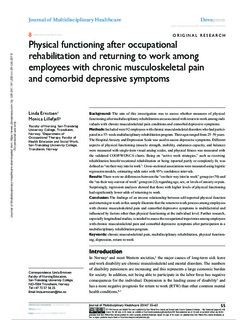| dc.contributor.author | Ernstsen, Linda | |
| dc.contributor.author | Lillefjell, Monica | |
| dc.date.accessioned | 2019-10-29T09:23:45Z | |
| dc.date.available | 2019-10-29T09:23:45Z | |
| dc.date.created | 2014-01-07T12:37:52Z | |
| dc.date.issued | 2014 | |
| dc.identifier.citation | Journal of Multidisciplinary Healthcare. 2014, 7 55-63. | nb_NO |
| dc.identifier.issn | 1178-2390 | |
| dc.identifier.uri | http://hdl.handle.net/11250/2625049 | |
| dc.description.abstract | Background: The aim of this investigation was to assess whether measures of physical functioning after multidisciplinary rehabilitation are associated with return to work among individuals with chronic musculoskeletal pain conditions and comorbid depressive symptoms.
Methods: Included were 92 employees with chronic musculoskeletal disorders who had participated in a 57-week multidisciplinary rehabilitation program. Their ages ranged from 25–59 years. The Hospital Anxiety and Depression Scale was used to assess depressive symptoms. Different aspects of physical functioning (muscle strength, mobility, endurance capacity, and balance) were measured with single-item visual analog scales, and physical fitness was measured with the validated COOP/WONCA charts. Being on "active work strategies," such as receiving rehabilitation benefit/vocational rehabilitation or being reported partly or completely fit, was defined as "on their way into/in work". Cross-sectional associations were measured using logistic regression models, estimating odds ratio with 95% confidence intervals.
Results: There were no differences between the "on their way into/in work" group (n=70) and the "on their way out/out of work" group (n=22) regarding age, sex, or levels of anxiety or pain. Surprisingly, regression analyses showed that those with higher levels of physical functioning had significantly lower odds of returning to work.
Conclusion: The findings of an inverse relationship between self-reported physical function and returning to work in this sample illustrate that the return-to-work process among employees with chronic musculoskeletal pain and comorbid depressive symptoms is multifactorial and influenced by factors other than physical functioning at the individual level. Further research, especially longitudinal studies, is needed to assess the occupational trajectories among employees with chronic musculoskeletal pain and comorbid depressive symptoms after participation in a multidisciplinary rehabilitation program. | nb_NO |
| dc.language.iso | eng | nb_NO |
| dc.publisher | Dovepress | nb_NO |
| dc.relation.uri | http://www.dovepress.com/articles.php?article_id=15604 | |
| dc.rights | Navngivelse-Ikkekommersiell 4.0 Internasjonal | * |
| dc.rights.uri | http://creativecommons.org/licenses/by-nc/4.0/deed.no | * |
| dc.title | Physical functioning after occupational rehabilitation and returning to work among employees with musculoskeletal pain and comorbid depressive symptoms | nb_NO |
| dc.type | Journal article | nb_NO |
| dc.type | Peer reviewed | nb_NO |
| dc.description.version | publishedVersion | nb_NO |
| dc.source.pagenumber | 55-63 | nb_NO |
| dc.source.volume | 7 | nb_NO |
| dc.source.journal | Journal of Multidisciplinary Healthcare | nb_NO |
| dc.identifier.doi | 10.2147/JMDH.S55828 | |
| dc.identifier.cristin | 1085059 | |
| dc.description.localcode | Open Access CC-BY-NC | nb_NO |
| cristin.unitcode | 194,65,20,0 | |
| cristin.unitcode | 194,65,30,0 | |
| cristin.unitname | Institutt for samfunnsmedisin og sykepleie | |
| cristin.unitname | Institutt for nevromedisin og bevegelsesvitenskap | |
| cristin.ispublished | true | |
| cristin.fulltext | original | |
| cristin.qualitycode | 1 | |

